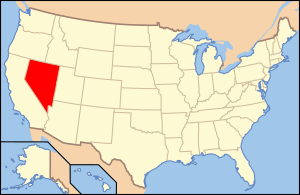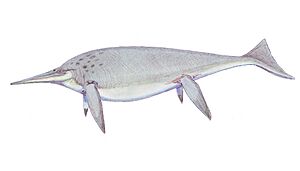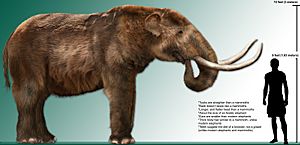Paleontology in Nevada facts for kids

Paleontology in Nevada is all about studying ancient life in the U.S. state of Nevada. Nevada has an amazing collection of fossils, showing plants and animals from the last 650 million years!
The very first fossils found in Nevada are from Esmeralda County. They are super old, from the Late Proterozoic time. These fossils are stromatolite reefs, which were built by tiny living things called cyanobacteria. Among these reefs, scientists found some of the oldest known shells ever, from creatures called Cloudina.
For much of the Proterozoic and Paleozoic eras, Nevada was covered by a warm, shallow, tropical sea. Because of this, many fossils found across the state are from sea animals. These include creatures like trilobites, brachiopods (shellfish), bryozoans (tiny colonial animals), and different kinds of corals.
After the Paleozoic era, the land in western North America started to move a lot. This movement pushed parts of Nevada that were once underwater up higher. During the Triassic period, northern and central Nevada were still shallow seas. These seas were between chains of mountains that looked like islands. In southern Nevada, there were swamps, much like what you'd find at Petrified Forest National Park.
By the Cretaceous period, all of Nevada was above sea level. It was mostly covered in mountains. The shallow seas of the Triassic were home to amazing creatures called Ichthyosaurs. Nevada's state fossil, Shonisaurus popularis, is a type of ichthyosaur. In the Jurassic and Cretaceous periods, dinosaurs and other land animals roamed the state.
After the Mesozoic era, in the Cenozoic era, Nevada's land stretched out. The mountains that formed when dinosaurs were alive started to fall apart. This created the modern Basin and Range area, with its many valleys and mountains. Not many fossils are found from the early Cenozoic (Paleogene) time. But there are lots of fossils from the later Cenozoic (Neogene) time across the state.
These Neogene fossils show many different kinds of mammals. These included camels, horses, giant ground sloths, rhinos, and tapirs. During this time, much of Nevada was covered in oak and redwood forests. This is very different from today's sagebrush deserts.
The Quaternary period in Nevada is known for its huge ancient lakes. The biggest ones were Lake Lahontan and Lake Bonneville. Fossils from this time show evidence of mammoths, a mastodon from Elko County, sabre-toothed cats, dire wolfs, and giant short-faced bears. Many animals still found in the Great Basin and Mojave Deserts today also lived then.
Contents
Ancient Nevada: A Journey Through Time

During the late Precambrian time, eastern and southern Nevada were slowly covered by a shallow sea. Tiny blue-green bacteria from this time were preserved as fossils. More than 500 types of ancient sea creatures lived in Nevada during the Cambrian, Devonian, and Carboniferous periods. Most of these were freshwater shellfish.
The sea kept growing into the state through the Devonian period. In northwestern Nevada, the sea got deeper, becoming a huge ocean basin. This deeper water was home to floating animals like graptolites. The shallower parts of the sea had many reefs. Near the end of the Devonian, a time of mountain building began. This event, called the Antler Orogeny, continued into the early Carboniferous.
As sea levels dropped, some parts of Nevada became dry land. Eastern Nevada had lagoons and beaches. Plants from these areas were preserved in the rocks. Northern and northeastern Nevada still had reef habitats. Northwestern Nevada remained a deep ocean, and its many tiny floating creatures left behind lots of fossils.
Nevada's sea level kept dropping during the Triassic period. However, the western part of the state was still quite deep. It was home to many ammonites (shelled creatures) and ichthyosaurs (giant swimming reptiles). During the Triassic, many small sea creatures lived and died in the area now called the Shoshone Mountains. Their fossils are very important. Many are used as "index fossils," which help scientists date rocks. Some were even completely new discoveries!
By the Jurassic period, only northwestern Nevada had deep marine habitats. Central Nevada was under shallow water, and eastern and southern Nevada had other types of environments. During the Cretaceous period, a chain of volcanic islands formed in far western Nevada.
Ancient plant fossils from Nevada include pieces of petrified wood found in Eureka County. These might be parts of ancient Sequoia trees. Dinosaurs found in Nevada included armored dinosaurs, possible duck-billed dinosaurs, and relatives of the horned dinosaurs.
During the Cenozoic era, huge changes in the Earth's crust created Nevada's Basin and Range area. Woodlands with trees like oak, redwood, and willow grew in Nevada. Animals living there included horses, mammoths, and rhinos. Volcanic eruptions happened often in Nevada during the Cenozoic.
Some of Nevada's Miocene life was preserved in rocks called the Truckie Beds. These are in the Kawich Mountains, northeast of modern Las Vegas. Local freshwater bodies had mollusks (shellfish). On land, Nevada was home to many mammals, including both mastodons and rhinoceroses.
As the Cenozoic continued, Nevada's Sierra Nevada Mountains were pushed up higher. Volcanic activity was still happening. Animals living then included camels, horses, mammoths, and giant ground sloths. Nevada has many trace fossils (like footprints) from the Pleistocene period. One site has footprints from many different creatures. These include birds, giant sloths, horses, lions, mastodons, and wolfs.
Mesozoic Marvels: Triassic Sea Creatures
The Triassic period lasted from about 251 to 201 million years ago. During this time, most of central and northern Nevada was a shallow, warm sea. Famous sites with ammonite fossils are found from Esmeralda County, north through Churchill County, and into Humboldt County.
The most famous animals in this shallow sea were ichthyosaurs. Many different kinds of Triassic ichthyosaurs have been found across Nevada. This includes the state fossil, Shonisaurus. Recently, scientists also found fossils of large, meat-eating ichthyosaur species in Pershing County. Ichthyosaurs in Triassic Nevada ranged in size from small, like a porpoise (Mixosaurus), to as big as a whale (Shonisaurus).
While central and northern Nevada were covered by the sea, southern Nevada was on the edge of the continent. Many of the same rock layers found in other southwestern states are also in southern Nevada. The oldest of these is the Moenkopi Formation. This formation recently gave us the oldest Mesozoic vertebrate tracks (footprints) from Nevada.
Above the Moenkopi Formation is the Chinle Formation. This formation has given us some Phytosaur teeth from the Muddy Mountains. It also has some bones of Metoposaurs from the Spring Mountains. And wherever it's found, there's lots of petrified wood. These rock layers show how southern Nevada changed from tidal flats to swampy river environments during the Triassic.
Discovering Nevada's Past: Scientific Research

The first serious fossil hunting in Nevada happened near Eureka. This fossil site was high up, at 6,000 feet. It was located between the basins of ancient Lake Bonneville and Lake Lahontan. Scientists found more than 500 kinds of ancient sea creatures from the Cambrian, Devonian, and Carboniferous periods. Most of these were freshwater shellfish. Many of them had never been seen by scientists before!
Another important early fossil discovery in Nevada happened by accident. Around the time of the California Gold Rush, the jail in Carson City needed more space. Workers blasted the sandstone walls to get material for building. This blasting revealed many fossil footprints! In 1882, scientists from the National Academy of Sciences studied the tracks. They figured out the footprints belonged to Pleistocene creatures like birds, horses, lions, mastodons, giant sloths, and wolfs.
In the early 1900s, a new fossil site was found in the Virgin Valley. This site had three layers rich in fossils. The bottom and top layers had many animal remains. These included two types of ancient camels, a large cat, two different kinds of horse, and remains that likely belonged to a rhinoceros and mastodons. Between these animal layers was a layer full of plant material, like leafs, logs, and stems.
In 1908, more discoveries were made in the Virgin Valley area. These were found in beds where people were digging for opal. Here, natural molds of twigs, limbs, and cracks in petrified wood were found. In 1912, a slab of rock was found near Esmeralda Field. It preserved fish, a primitive horse, shellfish, and plants.
In 1914, Miocene fossils were found in the Kawich Mountains northeast of Las Vegas. These included freshwater shellfish, mastodons, and rhinoceroses. This site is now known as the Truckie Beds. In 1930, M. R. Harrington was looking for Pueblo Indian pottery. By chance, he found the skull of a ground sloth in Gypsum Cave in southern Nevada. Harrington later went back and found more of the sloth's bones.
In 1933, the Tule Springs Expedition was the first big effort to explore the ancient importance of the area around Tule Springs. The Tule Springs Archaeological Site has fossils of ground sloths, mammoths, prehistoric horses, American camels, and the first giant condors found in Nevada.
Places to See Nevada Fossils
- Las Vegas Natural History Museum, Las Vegas
- Nevada State Museum, Carson City
- W.M. Keck Earth Science and Mineral Engineering Museum, Reno, Nevada
- Northeastern Nevada Museum, Elko, Nevada
- Nevada State Museum, Las Vegas
- University of California Museum of Paleontology, Berkeley, California
Fossil Parks in Nevada
- Berlin-Ichthyosaur State Park
- Ice Age Fossils State Park
- Tule Springs Fossil Beds National Monument

